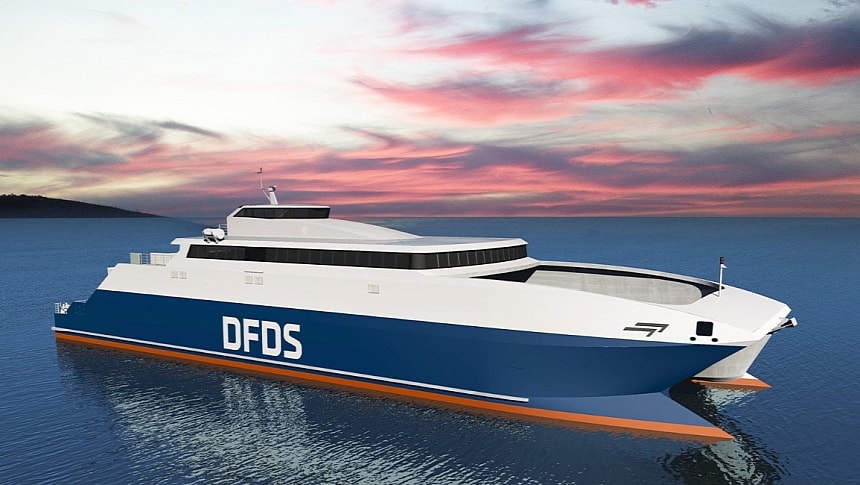A new partnership between two giants in the maritime industry will lead to the birth of a 100% green ferry more than 236-foot-long. What makes this project even more unique is that this innovative electric vessel will be built by one of the world's top sustainable shipyards.
Few people know that if Tasmania were a country, it would be among the top five worldwide in terms of running on 100% renewable energy. This is officially the greenest state in Australia and has been so for seven years in a row, a performance that's hard to match globally. And there's more. This trailblazing green state that covers all of its energy needs from renewable sources also houses one of the most prestigious shipyards.
Incat Tasmania gained a solid reputation back in the early '90s through its valuable contribution to the development of huge ferries for vehicle transportation and has successfully maintained its trailblazing status over the decades.
Two years ago, Incat announced it would be launching the world's largest high-speed, hybrid-electric ferry, an ambitious project that was completed last year.
Building on the success of its series-produced electric ships, the Tasmanian shipyard recently signed an agreement with DFDS, a Danish shipping company, for the construction of a new green ferry. The DFDS vessel will be 72 meters long (236.3 feet), and it will operate on European routes using hybrid-electric propulsion initially and battery-electric propulsion at a later date.
Incat's green ferries are based on a brand-new platform specifically designed for electric propulsion. Using its proven expertise in building aluminum vessels, Incat designed new-generation ferries that would be lightweight enough to operate as efficiently as existing ferries, even without burning fuel.
The current heavy-displacement ships made of steel don't only burn fuel, but they burn a lot of it. By comparison, these new-generation green ferries weigh almost half due to their state-of-the-art hull design and aluminum structure. This drastically cuts energy requirements, which makes them compatible with electric propulsion.
Another key factor, in addition to the lightweight structure, was the ability to operate at lower speeds. A ship that's designed to operate at a moderate speed will be able to function efficiently with fewer batteries, which saves even more energy and cuts costs.
Aluminum has many advantages compared to steel, apart from the energy-saving benefits. It boasts a higher corrosion resistance than steel, which overall increases the ferry's life cycle. It's also better for the environment, as steel re-coating processes result in a great deal of toxic waste, and ships that are made of steel require regular paint jobs and maintenance.
Since it's located in this pioneering green Australian state, Incat is also one of the few shipyards worldwide to power its operations exclusively with renewable energy. Designing and building green vessels was the natural next step.
Incat Tasmania gained a solid reputation back in the early '90s through its valuable contribution to the development of huge ferries for vehicle transportation and has successfully maintained its trailblazing status over the decades.
Two years ago, Incat announced it would be launching the world's largest high-speed, hybrid-electric ferry, an ambitious project that was completed last year.
Building on the success of its series-produced electric ships, the Tasmanian shipyard recently signed an agreement with DFDS, a Danish shipping company, for the construction of a new green ferry. The DFDS vessel will be 72 meters long (236.3 feet), and it will operate on European routes using hybrid-electric propulsion initially and battery-electric propulsion at a later date.
Incat's green ferries are based on a brand-new platform specifically designed for electric propulsion. Using its proven expertise in building aluminum vessels, Incat designed new-generation ferries that would be lightweight enough to operate as efficiently as existing ferries, even without burning fuel.
The current heavy-displacement ships made of steel don't only burn fuel, but they burn a lot of it. By comparison, these new-generation green ferries weigh almost half due to their state-of-the-art hull design and aluminum structure. This drastically cuts energy requirements, which makes them compatible with electric propulsion.
Another key factor, in addition to the lightweight structure, was the ability to operate at lower speeds. A ship that's designed to operate at a moderate speed will be able to function efficiently with fewer batteries, which saves even more energy and cuts costs.
Aluminum has many advantages compared to steel, apart from the energy-saving benefits. It boasts a higher corrosion resistance than steel, which overall increases the ferry's life cycle. It's also better for the environment, as steel re-coating processes result in a great deal of toxic waste, and ships that are made of steel require regular paint jobs and maintenance.
Since it's located in this pioneering green Australian state, Incat is also one of the few shipyards worldwide to power its operations exclusively with renewable energy. Designing and building green vessels was the natural next step.







